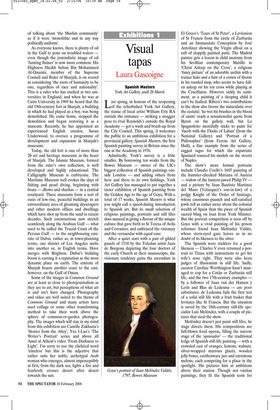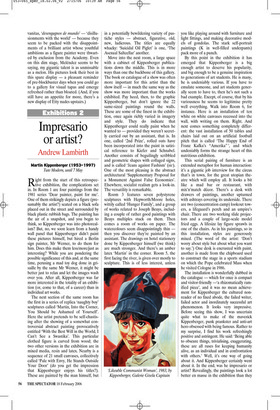Visual tapas
Laura Gascoigne
Spanish Masters York Art Gallery, until 26 March
Last spring, in honour of the reopening of the refurbished York Art Gallery, the statue of local artist William Etty RA outside the entrance — striking a swagger pose to rival Reynolds’s outside the Royal Academy — got a wash and brush-up from the City Council. This spring, it welcomes the public to an ambitious exhibition for a provincial gallery: Spanish Masters, the first Spanish painting survey in Britain since the one at the Academy in 1976.
Admittedly, York’s survey is a little smaller. By borrowing ten works from the Bowes Museum — owner of the UK’s biggest collection of Spanish paintings outside London — and adding others from here and there to its own holdings, York Art Gallery has managed to put together a taster exhibition of Spanish painting from the Golden Age to the age of Goya. With a total of 17 works, Spanish Masters is what you might call a speed-dating introduction to Spanish art. But its small selection of religious paintings, portraits and still lifes does succeed in giving a flavour of the unique culture that gave birth to St Teresa of Avila and Cervantes, and embraced the visionary and the vernacular with equal ease.
After a quiet start with a pair of gilded panels of 1510 by the Toledan artist Juan de Borgona depicting the four doctors of the early Church at their manuscripts, the visionary tendency gains the ascendant in El Greco’s ‘Tears of St Peter’, a Levitation of St Francis from the circle of Zurbarán and an Immaculate Conception by José Antolinez showing the Virgin afloat on a raft of sloppily painted putti. The Madrid painter gets a lesson in child anatomy from his Sevillian contemporary Murillo in ‘Christ Asleep on the Cross’, a religious ‘fancy picture’ of an adorable urchin with a trainer halo and a hint of a crown of thorns in his tousled mop, who seems to have fallen asleep on his toy cross while playing at the Crucifixion. However sickly its sentiment, as a painting of a sleeping child it can’t be faulted. Ribera’s two contributions to the show also favour the naturalistic over the ecstatic: ‘he wet his brushes in the blood of saints’ reads a sensationalist quote from Byron on the gallery wall, but Lo Spagnoletto mercifully sticks to paint for ‘Jacob with the Flocks of Laban’ (from the National Gallery) and ‘Portrait of a Philosopher’ (from Ferens Art Gallery, Hull), a fine example from the series of ragged sages for which the expatriate Spaniard sourced his models on the streets of Naples.
The show’s more formal portraits include Claudio Coello’s 1685 painting of the hamster-cheeked Mariana of Austria — widow of the lantern-jawed Philip IV and a picture by Juan Bautista Martinez del Mazo (Velazquez’s son-in-law) of a podgy Knight of the Order of Santiago, whose enormous paunch and self-satisfied jowls tell us rather more about the colonial wealth of Spain than the piece of Spanish sacred bling on loan from York Minster. But the portrait competition is seen off by Goya with a vivid painting of his prison reformer friend Juan Meléndez Valdés, whose stern-eyed gaze leaves us in no doubt of its likeness to the sitter.
The Spanish were sticklers for a good likeness — Charles V even returned a portrait to Titian with instructions to get his wife’s nose right. They were also keen judges of illusionism in still life. Sadly, curator Caroline Worthington hasn’t managed to cop for a Cotán or Zurbarán still life, and the two 17th-century examples by a follower of Juan van der Hamen y León and Blas de Ledesma — are poor substitutes: de Ledesma fails the first test of a solid still life with a fruit basket that levitates like St Francis. But the situation is saved by the 18th-century still-life specialist Luis Meléndez, with a couple of pictures that steal the show.
Meléndez doesn’t just paint still lifes, he stage directs them. His compositions are full-blown food operas, filling the narrow stage of the ‘aprarador’ — the traditional ledge of Spanish still-life painting — with a crowded cast of oranges, lemons, walnuts, silver-wrapped marrons glacés, wooden jelly boxes, earthenware jars and enormous melons, each competing for a place in the spotlight. His pictures hint at ambitions above their station. Though not vanitas paintings, they fit the Spanish term for vanitas, ‘desengagnos de mundo’ — ‘disillusionments with the world’ — because they seem to be packed with the disappointments of a brilliant artist whose youthful ambitions as a figure painter were thwarted by exclusion from the Academy. Even on this dim stage, Meléndez seems to be saying, my gigantic talent is as unmissable as a melon. His pictures look their best in this spare display — a pleasant reminder of pre-blockbuster days when you could go to a gallery for visual tapas and emerge refreshed rather than bloated. (And, if you still have an appetite for more, there’s a new display of Etty nudes upstairs.)



















































































 Previous page
Previous page